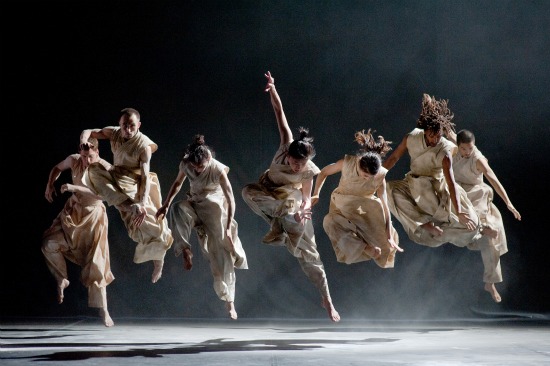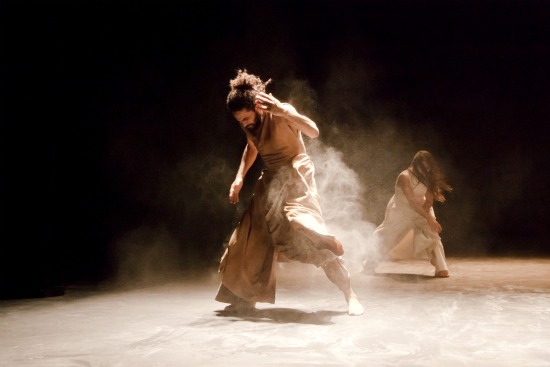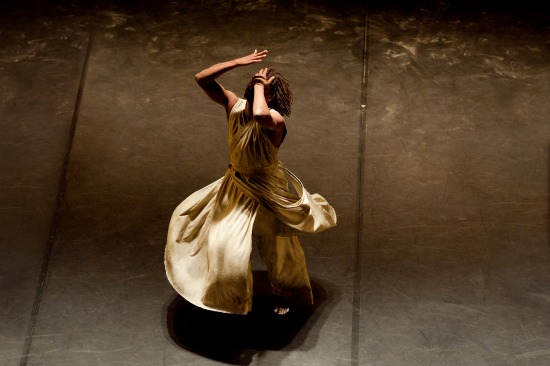The sound of distant dripping fills the darkness. Lights gradually, dimly, reveal a barely discernible standing figure. Suddenly the person plunges forward against what turns out to be a translucent curtain that stretches from one side of the stage to the other. Whenever his hands or his scribbling finger or his head presses against the flexible membrane separating him from us, that part comes instantly into sharp focus, while the rest of him remains blurry. His last thrust brings blackness again, and the sound of wind.
This is the stunning beginning of Akram Khan’s Vertical Road. An American premiere, it’s part of Peak Performances’ provocative series in the Alexander Kasser Theater at New Jersey’s Montclair State University. The London-based performer-choreographer recently tore his Achilles tendon and couldn’t show his Gnosis, a full-evening solo, on the February 9th program as scheduled. That’s a loss, because his movement style—contemporary yet rooted in the North Indian Kathak dance he studied from childhood and still practices—is one of the most striking things about his choreography, and Vertical Road (shown on the 8th, 10th, 11th, and 12th) is couched in a slightly looser—although still precise and powerful— vocabulary.
The ideas of the 13th-century Persian poet-philosopher Rumi inspired Khan’s images of a spiritual voyage for the eight dancers involved with his London-based company. Here’s one of the writer’s often quoted lines: “Dance, when you’re broken open. Dance, if you’ve torn the bandage off. Dance in the middle of the fighting. Dance in your blood. Dance when you’re perfectly free.” It is that steadfastness amid implicit turbulence that roils and spins through Vertical Road.
When Jesper Kongshaug’s magical lighting slowly reveals the stage again, there is no barrier, and the solo performer, Salah El Brogy, can wander freely among seven people clustered together, picking one man up as if he were a mannequin in a department store, moving him to a new place on stage, setting him down, and waiting to catch and reposition him when he topples. Not only do these people wear draped, off-white skirts and tops like El Brogy’s (costumes by Kimie Nakano); when we first see them, they’re covered with a white powder that sprays out in clouds when they begin to move. That’s the second visual shock, and an aural one occurs when El Brogy kneels beside what looks like a line of dark tablets standing on end and, in a single swipe, knocks them over with a resounding “clack!”
Together, alone, in pairs, the people make their private transformational journeys, although we don’t fully see what changes for them. They may cluster, then scatter, then reassemble in a temporary phalanx. Always they’re in touch with the ground—squatting, spreading their bent legs wide, dropping into deep lunges that bring to mind martial arts stances. They crawl; they roll; they spin on the floor into new positions with the limber fluidity of hip-hop dancers. Their jumps acknowledge the inevitable descent.
Your eye may be caught by a duet for Eulalia Ayguade Farro and Andrej Petrovic, a slow solo by tall, slender Yen-Ching Lin, a combat between Sung Hoon Kim and Elias Lazaridis, Ahmed Khemis standing still for what seems an eternity, El Brogy making Konstandina Efthymiadou spin until her skirts fly out and prying her off the partner who is carrying her away. The dancers are all fierce, wonderful (and Khan credits them with devising movement material for Vertical Road). Yet at some point around the middle of the dance, my concentration wanes, and I’m not sure why. Changes in the lighting indicate shifts in mood or the passage of time. Changes in Nitin Sawhney’s haunting score do the same. Yet in terms of the choreographic structure, the travelers’ sense of spiritual destination seems to weaken.
The ending, however, is clear and potent. Now El Salah is in front of the gleaming, translucent veil, raising his arms to heaven, while the lights turn rosy and the music becomes sweet, hymnlike. The others are behind that curtain, blurring into memory, only their reaching hands in sharp focus. Perhaps they were his phantoms all along. As their images fade and a low rumbling begins, he walks away from us toward them. In the last seconds of the dance he grasps the plastic barrier and yanks it down; the lights turn almost unbearably bright in the instant before it falls. Then everything goes black.
Khan himself has crossed lines in his life and work. After his terrific Kaash in 2002 and ma in 2004, he co-created and performed the wonderful duet zero degrees (2005) with Sidi Larbi Cherkaoui, about a traumatic border incident; Sacred Monsters, with ex-ballerina Sylvie Guillem in 2006; then the intriguing but less-than-splendid duet in-i with actress Juliette Binoche in 2008. That same year, Khan made Bahok with the National Ballet of China. I’d cross a boundary much more daunting than the Hudson River to see a work of his.




I believe we saw Kaash in Portland, which is considerably west of the Hudson River, several years ago as part of the tba (time-based art, whatever that means) festival and I thought it was a complete knockout. I’m always intrigued by the melding of eastern and western dance forms, especially if the choreographer comes by the melding honestly, as Akram Khan does. So I thank you Deborah for putting me in the theater with you, as always, and giving me the benefit of your highly-educated eye, not to mention your eloquent prose.
Samsara…